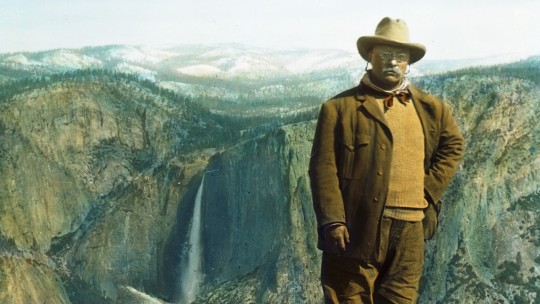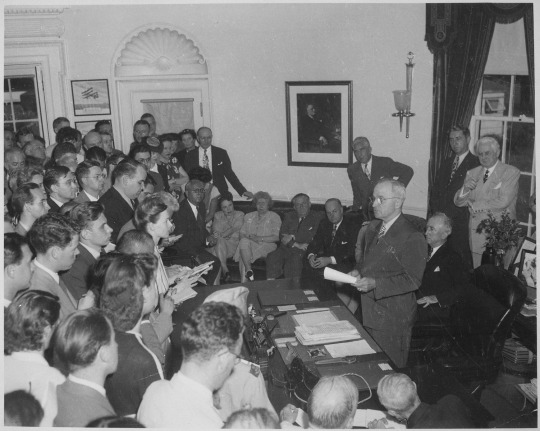#department of the interior
Explore tagged Tumblr posts
Text

Tom Dale: Department of the Interior (2014)
7K notes
·
View notes
Text

Yosemite Falls. Yosemite National Park - California.
#vintage illustration#yosemite falls#yosemite national park#california#national parks#scenic views#nature#national park service#department of the interior#america#america the beautiful
30 notes
·
View notes
Text
Excerpt from this story from The Desert Sun:
All of America's national monuments must be reviewed for potential oil and gas drilling and mining reserves, critics say, per bureaucratic language tucked deep in a sweeping order issued on Monday by newly sworn-in Interior Secretary Doug Burgum.
His order 3418, “Unleashing American Energy,” mandates that the Interior Department finish its initial monument review by Feb. 18.
That means 157 locations in 33 states and several national territories — including the freshly designated Chuckwalla National Monument and Sattitla National Monument in California — could be subjected to the expedited 15-day review, and attempts could be made to "revise" their boundaries.
Monuments protect cultural and historic resources and the lands that contain them, and are created by Congress or U.S. presidents. California has more monuments than any other state, with more than 4 million acres likely under review, one expert said, from popular desert off-roading trails to massive coastal redwoods. They include Mojave Trails, Sand to Snow, Carrizo Plain, Muir Woods, Devils Postpile, Cabrillo, Lava Beds, California Coastal, Sequoia NF, Cesar Chavez, Fort Ord, San Gabriel Mountains, Berryessa Snow Mountain and Castle Mountains.
The relevant portion of Burgrum's order includes “actions to review and, as appropriate, revise all withdrawn public lands, consistent with existing law, including 54 U.S.C. 320301 and 43 U.S.C. 1714."
Although not spelled out in plain English, those sections of code govern the Antiquities Act of 1906, under which 20 U.S. presidents have set aside millions acres of land and historic sites, from Alaska to Florida.
[Additional information from a story from Inside Climate News:
The order calls on the Interior’s assistant secretaries to identify in their action plans how to accomplish “actions to review and, as appropriate, revise all withdrawn public lands” under the Antiquities Act of 1906, the law that allows presidents to create national monuments, and the Federal Land Policy and Management Act of 1976, which outlines how federal lands can be used and allows for the establishment of national wildlife refuges and more. ]
Many Republican lawmakers have criticized presidents' use of the Antiquities Act to block mining, fossil fuels and other industrial development on federal monument lands.
But myriad environmental, hunting and fishing groups sharply condemned Burgum's actions, once the meaning became clear.
"Burgum knows that attacking monuments is incredibly unpopular, which is why he won't even use the words 'national monuments' or 'Antiquities Act' in his orders. He's trying to operate in secret here, and definitely does not want any public input," said Aaron Weiss, deputy director of Center for Western Priorities.
"This is a sneaky, unpatriotic attack that strikes at the very foundation of the country’s beloved public lands," a coalition of groups said in a news release condemning the order. "These national treasures are broadly beloved. They safeguard our water, buoy the outdoor recreation economy, protect our trails, and preserve a national heritage rich in culture and natural beauty. Attacks on the outdoors, such as this order from Secretary Burgum, threaten the $640-billion recreation economy, putting millions of jobs at risk."
The statement added that "the order fails to recognize that oil production hit record highs under the Biden administration. This isn’t about energy dominance. Washington politicians and their billionaire advisors have an unpatriotic anti-public lands agenda that aims to dismantle our national monuments for corporate polluters."
And here's a statement from the Conservation Lands Foundation:
These orders also willfully ignore the rural residents and communities whose personal and local incomes rely on these lands being protected from privatization. Outdoor recreation on BLM lands contributes more than $11 billion to the economy and substantial income to individuals, small and large businesses, and rural communities through hunting, fishing, camping, climbing, riding off-highway vehicles, and many other activities.
With roughly 85% of BLM lands already available for energy production–and roughly half of existing oil and gas leases not being used–it's crystal clear that these recent orders targeting the 15% of public lands that are protected for the public’s use have nothing to do with the nation’s energy portfolio.
There’s really no explanation other than this administration is trying to sneakily and greedily sell off the 15% of protected public lands to the wealthy and well-connected, thereby blocking access for everyone else. It’s an attack that flies in the face of America’s ideals and the Conservation Lands Foundation will be unrelenting in our fight on the side of the people–85% of voters in the west–who support keeping public lands in the public’s hands.
More information from the story from Inside Climate News:
Secretary Burgum’s order would also weaken protections for migratory birds, whose numbers are declining because of climate change, disease, changes in land use and habitat loss.
In North America, there are 3 billion fewer birds now than in 1970, according to federal documents. The populations of many of the 1,093 species protected under the Migratory Bird Treaty Act are also declining.
The intention of the Migratory Bird Treaty Act is to curb those losses by prohibiting the accidental killing and incidental takes—killings that are unintentional but not unexpected—of protected birds.
In his first term, President Trump weakened the MBTA to prohibit only deliberate killings of migratory birds, not incidental takes. The rule benefited business, development and energy companies because it “significantly reduced the activities that would result in liability,” according to the National Law Review. For instance, ponds of toxic waste that accidentally poison birds were no longer subject to the act’s restrictions.
The Biden administration rescinded the Trump rule and restored some protections for migratory birds while granting several exemptions for incidental takes.
The latest order would reinstate the rules implemented during the first Trump administration.]
#national monuments#Antiquities Act#trump#department of the interior#secretary doug burgum#Migratory Bird Treaty Act#Federal Land Policy and Management Act of 1976#national refuges
25 notes
·
View notes
Text
🤦🏽🤦🏻♂️🤦♀️
#department of the interior#Republican Doug Burgum#Trump’s Project 2025#republican assholes#never trump#maga morons#crooked donald#traitor trump#republican hypocrisy#trump’s shitty nominees
17 notes
·
View notes
Text
I wish
I told you the truth more.
— Mikko Harvey, from "Department of the Interior," Let the World Have You
376 notes
·
View notes
Text
Day 241: Macro photography of a fly

link
–This image is part of the public domain, meaning you can do anything you want with it! (you could even sell it as a shirt, poster or whatever, no need to credit it!)–
#public domain#art#copyright#free art#open source#flickr#flickblr#photography#biology#creative commons#no copyright#no copyright image#macro photography#maglev#nemaglev#zerene stacker#stackshot#geological survey#united states geological survey#department of the interior#droege#biml#bee inventory and monitoring laboratory#bug#bugs#canon#close-up#macro#insect#patuxent wildlife research center
8 notes
·
View notes
Text

LETTERS FROM AN AMERICAN
April 7, 2024 (Sunday)
HEATHER COX RICHARDSON
APR 08, 2024
In August 1870 a U.S. exploring expedition headed out from Montana toward the Yellowstone River into land the U.S. government had recognized as belonging to different Indigenous tribes.
By October the men had reached the Yellowstone, where they reported they had “found abundance of game and trout, hot springs of five or six different kinds…basaltic columns of enormous size” and a waterfall that must, they wrote, “be in form, color and surroundings one of the most glorious objects on the American Continent.” On the strength of their widely reprinted reports, the secretary of the interior sent out an official surveying team under geologist Ferdinand V. Hayden. With it went photographer William Henry Jackson and fine artist Thomas Moran.
Banker and railroad baron Jay Cooke had arranged for Moran to join the expedition. In 1871 the popular Scribner’s Monthly published the surveyor’s report along with Moran’s drawings and a promise that Cooke’s Northern Pacific Railroad would soon lay tracks to enable tourists to see the great natural wonders of the West.
But by 1871, Americans had begun to turn against the railroads, seeing them as big businesses monopolizing American resources at the expense of ordinary Americans. When Hayden called on Congress to pass a law setting the area around Yellowstone aside as a public park, two Republicans—Senator Samuel Pomeroy of Kansas and Delegate William H. Clagett of Montana—introduced bills to protect Yellowstone in a natural state and provide against “wanton destruction of the fish and game…or destruction for the purposes of merchandise or profit.”
The House Committee on Public Lands praised Yellowstone Valley’s beauty and warned that “persons are now waiting for the spring…to enter in and take possession of these remarkable curiosities, to make merchandise of these bountiful specimens, to fence in these rare wonders so as to charge visitors a fee, as is now done at Niagara Falls, for the sight of that which ought to be as free as the air or water.” It warned that “the vandals who are now waiting to enter into this wonderland will, in a single season, despoil, beyond recovery, these remarkable curiosities which have required all the cunning skill of nature thousands of years to prepare.”
The New York Times got behind the idea that saving Yellowstone for the people was the responsibility of the federal government, saying that if businesses “should be strictly shut out, it will remain a place which we can proudly show to the benighted European as a proof of what nature—under a republican form of government—can accomplish in the great West.”
On March 1, 1872, President U. S. Grant, a Republican, signed the bill making Yellowstone a national park.
The impulse to protect natural resources from those who would plunder them for profit expanded 18 years later, when the federal government stepped in to protect Yosemite. In June 1864, Congress had passed and President Abraham Lincoln signed a law giving to the state of California the Yosemite Valley and nearby Mariposa Big Tree Grove “upon the express conditions that the premises shall be held for public use, resort and recreation.”
But by 1890 it was clear that under state management the property had been largely turned over to timber companies, sheep-herding enterprises, and tourist businesses with state contracts. Naturalist John Muir warned in the Century magazine: “Ax and plow, hogs and horses, have long been and are still busy in Yosemite’s gardens and groves. All that is accessible and destructible is rapidly being destroyed.” Congress passed a law making the land around the state property in Yosemite a national park area, and the United States military began to manage the area.
The next year, in March 1891, Congress gave the president power to “set apart and reserve…as public reservations” land that bore at least some timber, whether or not that timber was of any commercial value. Under this General Revision Act, also known as the Forest Reserve Act, Republican president Benjamin Harrison set aside timber land adjacent to Yellowstone National Park and south of Yosemite National Park. By September 1893, about 17 million acres of land had been put into forest reserves. Those who objected to this policy, according to Century, were “men [who] wish to get at it and make it earn something for them.”
Presidents of both parties continued to protect American lands, but in the late nineteenth century it was New York Republican politician Theodore Roosevelt who most dramatically expanded the effort to keep western lands from the hands of those who wanted only their timber and minerals.
Roosevelt was concerned that moneygrubbing was eroding the character of the nation, and he believed that western land nurtured the independence and community that he worried was disappearing in the East. During his presidency, which stretched from 1901 to 1909, Roosevelt protected 141 million acres of forest and established five new national parks.
More powerfully, he used the 1906 Antiquities Act, which Congress had passed to stop the looting and sale of Indigenous objects and sites, to protect land. The Antiquities Act allowed presidents to protect areas of historic, cultural, or scientific interest. Before the law was a year old, Roosevelt had created four national monuments: Devils Tower in Wyoming, El Morro in New Mexico, and Montezuma Castle and Petrified Forest in Arizona.
In 1908, Roosevelt used the Antiquities Act to protect the Grand Canyon.
Since then, presidents of both parties have protected American lands. President Jimmy Carter rivaled Roosevelt’s protection of land when he protected more than 100 million acres in Alaska from oil development. Carter’s secretary of the interior, Cecil D. Andrus, saw himself as a practical man trying to balance the needs of business and environmental needs but seemed to think business interests had become too powerful: “The domination of the department by mining, oil, timber, grazing and other interests is over.”
In fact, the fight over the public lands was not ending; it was entering a new phase. Since the 1980s, Republicans have pushed to reopen public lands to resource development, maintaining even today that Democrats have hampered oil production although it is currently, under President Joe Biden, at an all-time high.
The push to return public lands to private hands got stronger under former president Donald Trump. On April 26, 2017, Trump signed an executive order—Executive Order 13792—directing his secretary of the interior, Ryan Zinke, to review designations of 22 national monuments greater than 100,000 acres, made since 1996. He then ordered the largest national monument reduction in U.S. history, slashing the size of Utah’s Bears Ears National Monument by 85%—a goal of uranium-mining interests—and that of Utah’s Escalante–Grand Staircase by about half, favoring coal interests.
“No one better values the splendor of Utah more than you do,” Trump told cheering supporters. “And no one knows better how to use it.”
In March 2021, shortly after he took office, President Biden announced a new initiative to protect 30% of U.S. land, fresh water, and oceans areas by 2030, a plan popularly known as 30 by 30. Also in March 2021, Supreme Court chief justice John Roberts urged opponents of land protection to push back against the Antiquities Act, saying the broad protection of lands presidents have established under it is an abuse of power.
In October 2021, President Biden restored Bears Ears and Escalante–Grand Staircase to their original size. “Today’s announcement is not just about national monuments,” Interior Secretary Deb Haaland, a member of the Laguna Pueblo in New Mexico, said at the ceremony. “It’s about this administration centering the voices of Indigenous people and affirming the shared stewardship of this landscape with tribal nations.”
In 2022, nearly 312 million people visited the country’s national parks and monuments, supporting 378,400 jobs and spending $23.9 billion in communities within 60 miles of a park. This amounted to a $50.3 billion benefit to the nation’s economy.
But the struggle over the use of public lands continues, and now the Republicans are standing on the opposite side from their position of a century ago. Project 2025, the blueprint for a second Trump presidency, demands significant increases in drilling for oil and gas. That will require removing land from federal protection and opening it to private development. As Roberts urged, Project 2025 promises to seek a Supreme Court ruling to permit the president to reduce the size of national monuments. But it takes that advice even further.
It says a second Trump administration “must seek repeal of the Antiquities Act of 1906.”
LETTERS FROM AN AMERICAN
HEATHER COX RICHARDSON
#Letters From An American#Heather Cox Richardson#public lands#the Antiquities Act of 1906#history#Department of the interior#tribal nations#Teddy Roosevelt#conservation#conservatism#preservation
12 notes
·
View notes
Text
The billionaire governor of North Dakota – like most picks to lead the Department of the Interior, the largest landowner in the US west – comes from a western state. He is not a conspiracy theorist, he hasn’t been investigated for sex trafficking. Unlike the president-elect’s pick to lead the Department of Energy, he is not a fracking CEO.
“He’s not a lunatic,” said Patrick Donnelly, the great basin director for the Center for Biological Diversity. “He’s not someone wholly inappropriate for the job. But I fear the way his extractive agenda will play out in public lands.”
Over the next four years, Burgum is poised to radically remake the agency that oversees 500m acres (200m hectares) of public lands, including national parks and wildlife refuges. A former software executive and one-time climate pragmatist, Burgum has become closely enmeshed with oil and gas industry executives.
Burgum led the Trump campaign’s development of its energy policy. After Trump asked oil executives to steer $1bn toward his campaign, Burgum promised them Trump would halt Joe Biden’s “attack” on fossil fuels. As Trump makes good on his promise to “drill, baby, drill”, Burgum will be overseeing the department that expedites those drilling permits.
“There’s going to be an effort to get every ounce of fuel out of the ground and burn it,” said Daniel R Patterson, a former environmental protection specialist for the Bureau of Land Management (BLM), a division of interior, who filed a whistleblower complaint during the first Trump administration. “And if we do that, we’re burning ourselves.”
Burgum had long had an affinity for Teddy Roosevelt, the US president who established the national parks system and was a champion of the outdoors. Roosevelt was from New York, but had a special connection to the Dakotas, seeking solace in the region’s sweeping badlands.
The 26th president was also known for his machiavellian political philosophy. “Teddy Roosevelt encouraged America to speak softly and carry a big stick,” Burgum said at the Republican national convention in Milwaukee. “Energy dominance will be the big stick that President Trump will carry.”
In addition to managing the interior department, Trump has also tasked Burgum with serving as an “energy czar”, overseeing energy policy across the federal government at the helm of a new “national energy council”.
He will be, in essence, a fox guarding the henhouse – in a position to tear down environmental regulations, and ramp up extraction. “We’re going to see a hard turn, to almost complete hostility to conservation interests,” said Patterson.
With Burgum at the head of the department, Patterson added, “the direction from DC is going to be to permit as much resource exploitation as possible. And interior employees are going to be asked to push the boundaries of the law more.”
Burgum’s zeal for extraction – and his focus on ramping up oil and gas production – could make him more efficient and effective than Trump’s previous interior secretaries. Trump’s first interior leader, Ryan Zinke, racked up 18 ethics investigations in just under two years. His replacement David Bernhardt was also dogged by allegations of ethics violations – and was investigated for carrying on his work as an oil industry lobbyist even after he joined the administration.
Burgum’s relatively short political career has not been without scandal. During his short-lived presidential bid, he drew attention for offering $20 gift cards to people who would donate $1 to his campaign, so he would have enough individual donors to make the Republican primary debate stage. But until quite recently, Burgum was viewed as a relative moderate.
Initially, he was known for his bipartisanship and pragmatism. Tribal leaders in North Dakota have credited him with smoothing tenuous relationships between tribal and state governments, and though he urged the federal government to take quicker action to clear out protesters of the Dakota Access Pipeline, he advocated against using force after taking over as governor toward the end of the standoff.
He was never a progressive champion of climate action – but he promoted the same “all of the above” approach to energy that Democratic administration have supported, backing North Dakota’s powerful oil and gas industry while also encouraging the development of renewable energy infrastructure. In 2021, he set a goal that North Dakota would stop adding carbon dioxide to the atmosphere by 2030, becoming “carbon neutral” – advocating for a plan that retained the state’s fossil fuel industries while investing in carbon capture and storage technologies to offset emissions. At the time, environmental groups supported Burgum’s pledge, but noted the impracticality of relying on unproven carbon capture technology rather than a transition away from fossil fuels.
But in the past year and a half, Burgum underwent a Maga conversion, becoming one of Donald Trump’s closest advisers on energy policy, coordinating closely with oil industry executives.
#excerpts#department of the interior#fossil fuels#climate change#north dakota#us politics#uspol#public lands#conservation
2 notes
·
View notes
Text

US President Truman announcing Japan's surrender
White House, Washington DC
August 14, 1945
rayeshistory.com
17 notes
·
View notes
Text


DESERT AWARENESS
"The history of the desert is a colorful parade of American people. If you want your own glimpse of the parade, remember to look at the messages left by the former inhabitants, and to seek out the folks who have been there a long, long time. Take a minute to look through their eyes at the desert and its history." (7)
Desert Awareness is a short illustrated guide to the California desert by Cathy Klinesteker and the Bureau of Land Management, "written for desert users by desert users" (1). Klinesteker explores the diverse history of people, plants, and animals who live in and interact with the desert. Full color photographs of stunning California vistas by Terry Hickson and Carl Rice, along with adorable illustrations by Virginia Schoeffler bring the desert to life for readers. Desert Awareness embraces the reality of human interaction with the land and the part that we play in the desert ecosystem, from Indigenous communities to hikers, campers, scientists, archeologists, and land management.
The approachable nature and broad scope of this short book means anyone interested in exploring or learning about the California desert will find accessible and responsible ecological information. As a Department of Interior, Bureau of Land Management publication, the guide also includes lists of local BLM offices, a robust references list, and Awareness Activities. Meant for individual or group reflection, Klinesteker explains that these activities are "a reminder that I am connected to the world and to survive, I must take care of it" (46).
note: some of the terminology and phrasing relating to Indigenous peoples is out of date and may be considered inaccurate or offensive.
Citation: Klinesteker, C., United States. Bureau of Land Management., Schoeffler, V., Hickson, T., Rice, C., & United States. Bureau of Land Management. (1977). Desert awareness. Dept. of the Interior, Bureau of Land Management.
Full text available via HathiTrust.
2 notes
·
View notes
Text
I have reason to believe, based on a rabbit hole I went down last night, that there is an ongoing war happening between the National Parks Service and the US Park Police. I take no joy in reporting that the National Parks Service isn't immune from ACAB, with the Park Police being undisciplined dickhead cowboys with unchecked authority in the greater DC Metro area. Even the local county police hate them to the point of leaking evidence the Park Police have withheld from the public and bringing manslaughter charges against Park Police officers following the killing of Binam Ghaisar. Charges that were only stopped by FBI intervention and a proceeding cover up. The legacy of which haunts the organization and colors everything that has happened in the last few months.
There seems to have been what I can only describe as a soft coup by appointing Jessica Taylor as park police chief. The park police union has been eroding the legitimacy of the National Parks Service (otherwise a very progressive liberal institution in comparison to basically every other US government agency) for decades now and I think the wider agency is trying to reign them in even if that means bringing in a rival ex Secret Service hatchet-woman turned EPA auditor. Its worth noting that the Secret Service have a long history of resentment towards the Park Police due to overlapping jurisdictions within Washington DC and their general lack of discipline with their rivalry often breaking out into outright hostility including the assault and detention of a black Secret Service agent. Being a former Secret Service agent, Taylor would be well aware of the Park Police's reputation before her appointment.


Her appointment was rushed through by Park Service’s associate director of visitor and resource protection Jennifer Flynn, seemingly against the wishes of the police union who expected the Park Service to rubber stamp their candidate like previous appointments.

To which I say-- Lol. Lmao even. The Park Police are clearly used to appointing their own oversight and have an incredibly disproportionate amount of power within the NPS that is increasingly at odds with the rest of the agency. All this in mind, it really reads like Flynn brought Taylor in as a deliberate outsider in the hopes of bringing more oversight to the organization that won't immediate fold to the union or engage with their over-up plans every time the Park Police murder someone.

Jennifer Flynn, for her part, doesn't come from the Park Police but instead spent her whole career as a Park Ranger working in various capacities. Maybe its just me but when you see her you think "oh yeah that's definitely what I would expect a park ranger to look like" unlike the hotdog necks at the USPP. While only the associate director, she's been working quietly and smartly to find ways to reign in the park police including amending their jurisdiction over "felony investigations of property crimes, and crimes against society such as serious drug related offenses" under the guise of staffing cuts. To be clear, she unilaterally made the decision that the Park Police may no longer investigate or arrest citizens for non-violent offenses. Again, I can't help but see this as a direct response from sympathetic members of the agency to the Park Police's killing of Bijan Ghaisar to gradually remove the Park Police's authority to carry out law enforcement except when absolutely necessary.
Its an interesting situation to be sure, and while I don't count these two ladies as any sort of socialist heroes on "our side" (they're federal enforcement officers at the end of the day) I'm willing to lend them critical support in their attempts to quietly defang the Park Police. Maybe its wishful thinking but I like to imagine based on everything I've read that there is some sort of concentrated deliberate effort being done here that's successfully circumvented politics by *actually wielding authority to drive positive change* even if they know the limits of their authority necessitates that they do it quietly. USPP clearly thinks of themselves as police officers first and members of the National Parks Service second, and are clearly at odds with the rest of their organization's values. I hope this continues until we see the Park Police be restructured into glorified mall cops with no institutional influence while the bulk of their role is taken over by more responsible organizations within the NPS like the National Park Service Law Enforcement Rangers and other special agents that prioritize the safety of the public over brutalizing people over property enforcement & petty crimes.
Why am I posting this here???... Because so much of my writing has to do with the National Parks Service and the Department of the Interior. Here I am with potentially a genuine case of inter-agency intrigue while conducting completely unrelated research. You can't blame me for wanting to dig into this more and see where it goes. Consider this a story, food for thought, when thinking about these organizations.
16 notes
·
View notes
Text
A pair of conservation coalitions on Monday made good on their threats to sue the U.S. government over its denial of federal protections for gray wolves in the northern Rocky Mountains, where state killing regimes "put wolves at obvious risk of extinction in the foreseeable future."
The organizations filed notices of their plans for the lawsuits in early February, after the U.S. Fish and Wildlife Service (FWS) determined that Endangered Species Act protections for the region's wolves were "not warranted." The Interior Department agency could have prevented the suits in the U.S. District Court for the District of Montana by reversing its decision within 60 days but refused to do so.
"The Biden administration and its Fish and Wildlife Service are complicit in the horrific war on wolves being waged by the states of Idaho, Wyoming, and Montana," declared George Nickas, executive director of Wilderness Watch, one of 10 organizations represented by the Western Environmental Law Center (WELC).
"Idaho is fighting to open airstrips all over the backcountry, including in designated Wilderness, to get more hunters to wipe out wolves in their most remote hideouts," Nickas noted. "Montana is resorting to night hunting and shooting over bait and Wyoming has simply declared an open season."
Brooks Fahy, executive director of Predator Defense, another WELC group, pointed out that "these states are destroying wolf families in the Northern Rockies and cruelly driving them to functional extinction via bounties, wanton shooting, trapping, snaring, even running over them with snowmobiles. They have clearly demonstrated they are incapable of managing wolves, only of killing them."
KC York, founder and president of Trap Free Montana, also represented by WELC, said that "Montana, Idaho, and Wyoming know that they were let off the hook in their brutal and unethical destruction of wolves even acknowledged as such by the service."
"They set the stage for other states to follow," York warned. "We are already witnessing the disturbing onset of giving the fox the key to the hen house and abandoning the farm. The maltreatment is now destined to worsen for these wolves and other indiscriminate species, through overt, deceptive, well-orchestrated, secretive, and legal actions."
The other organizations in the WELC coalition are Alliance for the Wild Rockies, Friends of the Clearwater, International Wildlife Coexistence Network, Nimiipuu Protecting Our Environment, Protect the Wolves, Western Watersheds Project, and WildEarth Guardians.
The second lawsuit is spearheaded by the Center for Biological Diversity, Humane Society of the United States, Humane Society Legislative Fund, and Sierra Club, whose leaders took aim at the same three states for their wolf-killing schemes.
"The states of Montana, Idaho, and Wyoming act like it's 1880 with the most radical and unethical methods to kill as many wolves as possible in an effort to manage for bare minimum numbers," said Sierra Club northern Rockies field organizer Nick Gevock. "This kind of 'management' is disgraceful, it's unnecessary, and it sets back wolf conservation decades, and the American people are not going to stand by and allow it to happen."
Margie Robinson, staff attorney for wildlife at the Humane Society of the United States, stressed that "under the Endangered Species Act, the U.S. Fish and Wildlife Service cannot ignore crucial scientific findings. Rather than allow states to cater to trophy hunters, trappers, and ranchers, the agency must ensure the preservation of wolves—who are vital to ensuring healthy ecosystems—for generations to come."
The Center for Biological Diversity's carnivore conservation program director, Collette Adkins, was optimistic about her coalition's chances based on previous legal battles, saying that "we're back in court to save the wolves and we'll win again."
"The Fish and Wildlife Service is thumbing its nose at the Endangered Species Act and letting wolf-hating states sabotage decades of recovery efforts," Adkins added. "It's heartbreaking and it has to stop."
#ecology#enviromentalism#biden administration#us politics#let wolves live#wolves#endangered species act#us fish and wildlife service#wildlife services#wildlife#Fuck Wildlife Services#montana#idaho#wyoming#department of the interior#center for biological diversity
3 notes
·
View notes
Text
A rogue ranger is documenting every National Park Service firing. (SFGate)
Excerpt from this story from SFGate:
In an act of resistance, park rangers are banding together to crowdsource terminations and catalog the number of National Park Service employees the Trump administration has fired in every park unit across the country.
The rangers want the public to know how many people got fired on Feb. 14 in what’s being called the “Valentine’s Day Massacre,” says one seasonal park ranger who is leading the charge. The ranger requested anonymity to protect their job, which was granted in accordance with Hearst’s ethics policy.
The rangers want the public to know how many people got fired on Feb. 14 in what’s being called the “Valentine’s Day Massacre,” says one seasonal park ranger who is leading the charge. The ranger requested anonymity to protect their job, which was granted in accordance with Hearst’s ethics policy.
But numbers in individual national parks are hard to come by. Spokespeople for several national parks referred SFGATE’s questions about the rangers’ list and numbers of fired employees to the National Park Service Office of Communications. The office replied with a statement that didn’t answer any questions. “The National Park Service is hiring seasonal workers to continue enhancing the visitor experience as we embrace new opportunities for optimization and innovation in workforce management,” the Park Service press team wrote. “We are focused on ensuring that every visitor has the chance to explore and connect with the incredible, iconic spaces of our national parks.”
“The official list that OPM likely contains has not been made public and likely will never be public, so us park rangers decided to make one ourselves,” the ranger wrote, referring to the Office of Personnel Management.
Together, park rangers say they’ve collaboratively verified more than 750 of those firings in the past week and a half. Some parks lost just one employee, while Shenandoah National Park and Everglades National Park, for example, lost 15 each, according to the document.
Jeff Mow, the superintendent of Glacier National Park between 2013 and 2022, called the terminations “indiscriminate” and “very uneven.” “It’s so chaotic,” Mow said.
The spreadsheet does not include job offers that the Trump administration rescinded, seasonal positions that were frozen or vacant positions that have gone unfilled. The spreadsheet also doesn’t include more than 700 National Park Service employees who responded to the “Fork in the Road” email with their resignations.
Former superintendent Mow said parks like Glacier may be impacted by additional layoffs in surrounding lands, including national forests. Glacier, for example, works in tandem with public land management agencies and tribes nearby to respond to wildfires. “Glacier National Park does not have the staff to put people out on 17 separate lightning strikes,” he said.
When nearby trail crews are decimated, or the Forest Service doesn’t hire seasonal workers who sometimes chip in on fires, that can have a ripple effect on national parks nearby, even if their own staffing remains mostly intact. “It could result in more closures of the park during fire season,” Mow said. Thousands of Forest Service employees were also fired Feb. 14, although a small number of people are beginning to be rehired, according to E&E News.
29 notes
·
View notes
Text
1968-michaelharrelljr.com passed Baron Samedi's Shadowy Gates of Immortal Death [I.D.] on Earth [Qi]... Again... since Eye 1698 TUTANKHAMÚN [E.T.] Living [EL] behind My Father's Extremely Wealthy [FEW] Gated Death Communities [D.C.] in Mother's [DMS] Old 1698-2223 America [Mu Atlantis]
WELCOME BACK HOME IMMORTAL [HIM] U.S. MILITARY KING SOLOMON-MICHAEL HARRELL, JR.™

i.b.monk [ibm.com] mode [i’m] tech [IT] steelecartel.com @ quantumharrelltech.ca.gov

1st eye of tutankhamún [e.t.] ain't dead!!!

Death is the real [Dr] 9 ether life [el] realm on earth?!?!?!

eye back from life [death] on parallel earth [qi] of death [life]!!!... back 2 life back 2 reality

SEE?!?!?!

1968-michaelharrelljr.com Incarnated as Extremely Wealthy TUTANKHAMÚN... Died Contractually [D.C.] Wealthy on Earth [WE]... only 2 come back on Earth [Qi] Wealthier than before

we already see everything before it happens on earth [qi]

We still here... Immortal Souls never die

Eye Scriptural 9 Ether Job from Mother's Ægiptian [ME = MENES] Bible of Gullah Geechee's Extreme Wealth [GEW = JEW] DYNASTIES?!?!?!

FOUND IT!!!... wait... how many gated wealth estates [we] do we own?!?!?! 144,000?!?!?!... Chile, please!!!

1968-michaelharrelljr.com in a cult... or occult from okc?!?!? ANCIENT 9 ETHER OKCULT SKY ILLUMINATI of BLACK WALL STREET... IN CALIFORNIA?!?!?!

u still [u.s.] lost in 2023?!?!?!... STILL?!?!?!... OMFGOD MICHAEL [OM]!!!

go find your ancient 9 ether dna/rna geological land patents in father's predynastic ægipt of mother's old america [mu atlantis]!!!

we deep inside tiamat's grand canyon in mother's old america [mu atlantis]

eye see u quietly spying on harrelltut.com

1st eye of tutankhamún [e.t.] at the top [e.t.]... deep inside inner earth [qi]... on earth [qi]

look at my gingerbread brown gold melanin tech pyramid dynasty of tutankhamún @ © 1698-2223 quantumharrelltelecom.tech

eye illuminati... eye illuminati... eye illuminati... sing it loud!!!... eye illuminati... eye illuminati... eye illuminati... sang it proud!!!... eye illuminati... eye illuminati... eye illuminati

© 1698-2223 quantumharrelltech.com - ALL The_Octagon_(Egypt) DotCom [D.C.] defense.gov Department Domain Communication [D.C.] Rights Reserved @ quantumharrelltech.ca.gov
#u.s. michael harrell#quantumharrelltech#king tut#mu:13#harrelltut#kemet#o michael#quantumharrelltut#department of the treasury#department of the interior#department of defense#the octagon#the pentagon#gullah geechee#gullah gullah island#black wall street#gews#black wall street gews#kingtutdna#the dead are alive#humans are the walking dead#biblical job#144000
5 notes
·
View notes
Text
I can imagine that the Trump administration would do something like this.
Satire, but the Trump gang are still fucking assholes.

Fulfilling a campaign promise made by President Donald Trump, the U.S. Department of the Interior announced Wednesday that it was enacting a ban on unlikely animal friendships, effective immediately. “Starting today, any animal found frolicking or snuggling with an animal of another species—for example, a chimp cuddling a puppy or a magpie preening a pig—is in violation of the law and will be prosecuted accordingly,” said Interior Secretary Doug Burgum, adding that the word “unlikely” would be replaced with the more scientifically accurate descriptor “unnatural” in all government documents going forward.
Full Story
950 notes
·
View notes
Text
The Endangered Species Act is one of the most successful environmental laws ever passed, saving treasured species like gray wolves, sea otters, bald eagles and grizzly bears. It’s also been critical to the success of local economies that depend on these very species to thrive and can protect against losses caused by oil and gas projects and mineral extraction.
But bad actors are trying to GUT the Endangered Species Act – all to benefit corporate interests and wealthy developers – and government agencies aren’t doing enough to protect it. If we don’t fight back, fragile species will be driven to extinction! We can’t let anyone weaken this vital legislation.
Add your name today to demand the Department of the Interior protect the Endangered Species Act!
@upontheshelfreviews
@greenwingspino
@one-time-i-dreamt
@tenaflyviper
@akron-squirrel
@ifihadaworldofmyown
@justice-for-jacob-marley
@voicetalentbrendan
@thebigdeepcheatsy
@what-is-my-aesthetic
@ravenlynclemens
@writerofweird
@anon-lephant
@mentally-quiet-spycrab
@therealjacksepticeye
#actually important#signal boost#fuck trump#environmental protection#environmentalism#petition#Department of the Interior#Endangered Species Act#Endangered Species
1 note
·
View note